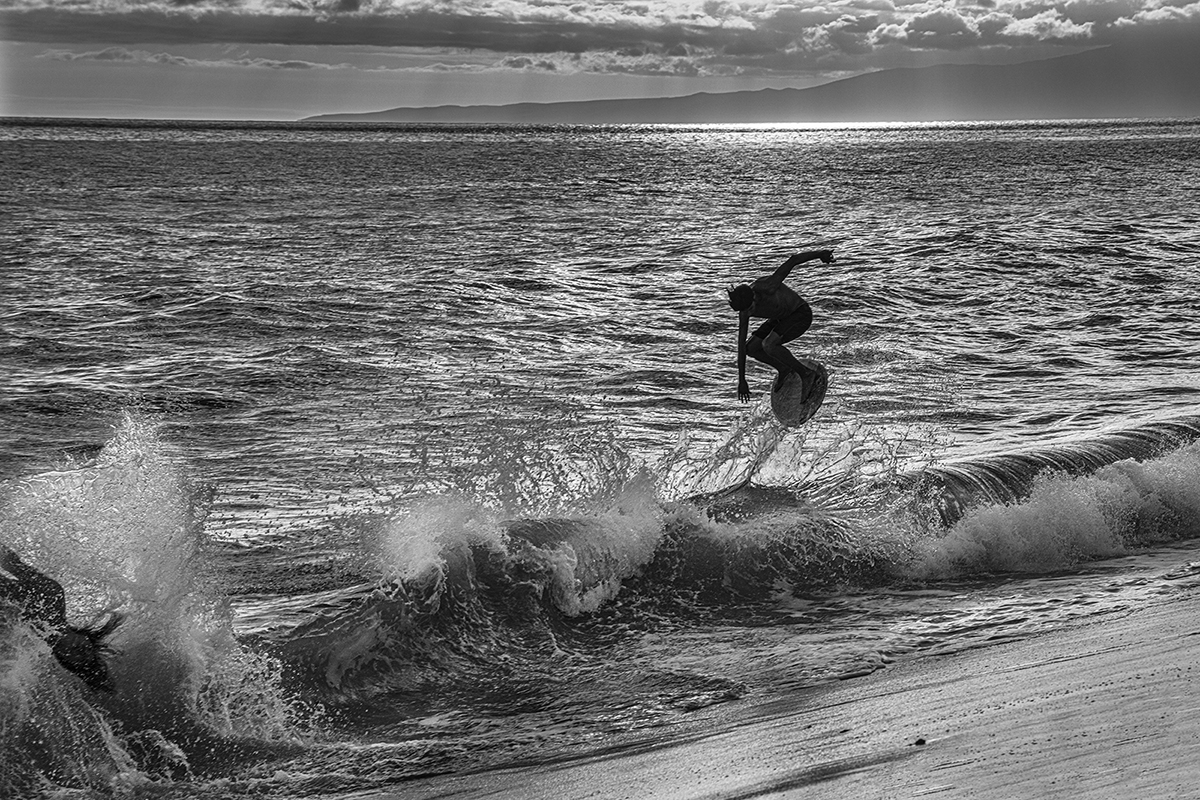High-Octane Wave Riding
Michael Gilbert catches the skimboarding’s acrobatic feats with the 28-200mm Di III RXD, 70-180mm Di III RXD and his trusty SP 70-200mm lenses.
More Photo Tips | Video Gallery | Photo Gallery | Enewsletter sign-up
By Jenn Gidman
Images by Michael Gilbert
Things have been rather quiet for Michael Gilbert over the past five months as he’s hunkered down at his Maui home during the pandemic. What he’s been grateful for during this universal slowdown is the chance to brush up on his social media skills, and also to experiment with the new Sony mirrorless camera system he recently transitioned to, as well as the two new Tamron lenses he has to go with that system.
“Going mirrorless with the Tamron 28-200mm Di III RXD and 70-180mm F/2.8 Di III VXD lenses has opened up a whole new way of shooting for me,” Michael says. “It’s cut down the weight of my equipment substantially, which is important as I’m trying to navigate the lava fields in the middle of the night to capture the Milky Way. Plus, those lenses are so fast and offer such superb quality. I have some pictures where it’s hard to believe they’re not Photoshopped.”
Michael recently discovered a sport he could capture with his new lenses: skimboarding, a variant on surfing in which participants use smaller versions of surfboards to glide across the water from the beach to meet the breaking waves, where they then perform different surface and air maneuvers. “My assistant knows about this kind of stuff and talked me into going down to a beach I don’t normally go to in Makena, where all of these skimboarders hang out,” he says. “It’s notably different from surfing, because they’re doing many of their moves right where the sand and the ocean meet.”

70-180mm (70mm), F/5.6, 1/1000th sec., ISO 100
Click image to view larger
When he first started photographing the skimboarders, Michael had to study them to learn some of their maneuvers and be able to anticipate what they’d do next. “It’s incredibly acrobatic,” he says. “For instance, they really know how to control their back foot, which leads to a long ribbon of water that eventually explodes into the air. It took me a bit to figure out just the right shutter speed so that I’m able to capture both the larger clumps of water as well as the droplets spraying up into the air. I’m usually only able to capture that between 1/800th and 1/1250th of a second.”
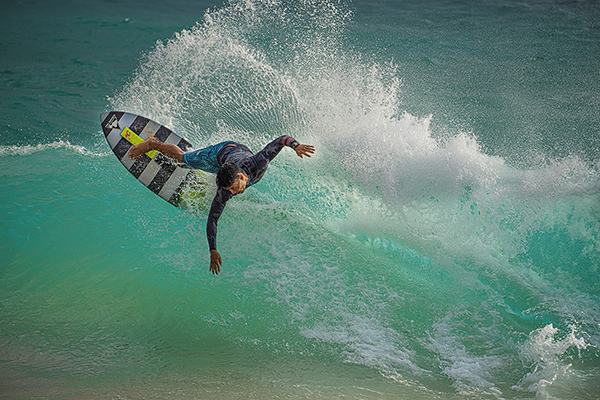
70-180mm (180mm), F/4, 1/1000th sec., ISO 100
Click image to view larger
Michael typically heads down to the beach at around 4 p.m. and stays till sunset. “During that time, usually around 5 or 5:30, the light will come in from behind the wave and light it right up,” he says. “It’s this sweet spot in which the light comes in at that oblique angle, and when the skimboarder slashes through the water, you can see the wave explode in a way that only happens at that time of day.”

70-200mm (200mm), F/6.3, 1/1000 sec., ISO 100
Click image to view larger
Exposing for the water allows Michael to keep his backgrounds from blowing out. “With today’s cameras and all of those megapixels, the more data I can move around and the more shadows I can open up,” he says. “As long as I don't blow out my highlights, I can deal with my shadows up to, say, four stops.”
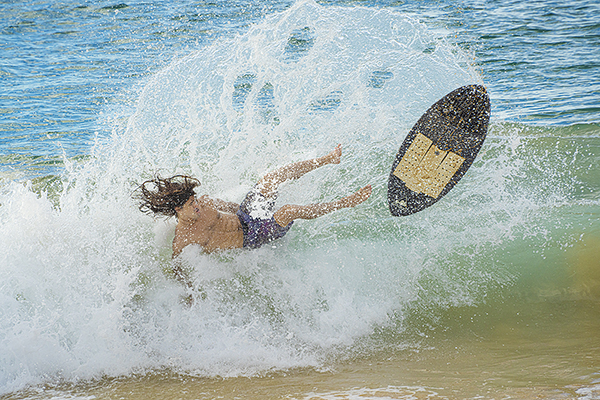
28-200mm (200mm), F/8, 1/1250th sec., ISO 640
Click image to view larger
The skimboarders are willing performers in front of Michael’s camera, and because they don’t have to swim all the way out past the break to start the action, he’s able to keep suggesting moves that he thinks will look aesthetically pleasing in his photos. “In the picture here where you can see the Molokini Crater in the background, I wanted this guy with long hair, whose name is Johnny, to see if he could flip upside down for me, so that his hair would go flying in the air,” he says. “He went out and caught the next wave for me, just so I could capture this picture.”
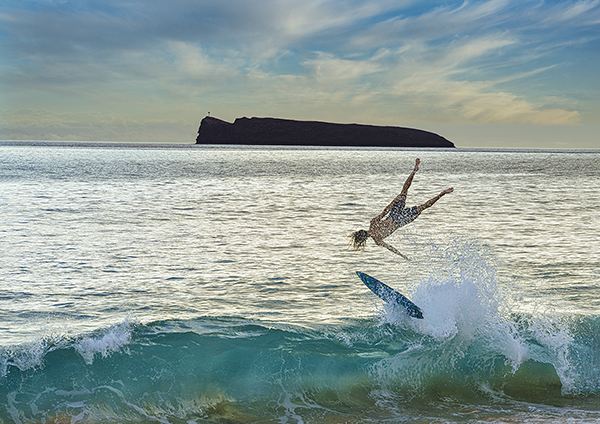
28-200mm (142mm), F/19, 1/1250th sec., ISO 640
Click image to view larger
One of Michael’s images doesn’t depict Maui’s skimboarders, but a kiteboarder he was able to capture while cruising over the ocean in a helicopter. “This was at a place called Jaws, Maui’s most famous surf spot, with some of the biggest waves in the world,” he says. “They can be upward of 50 feet.”
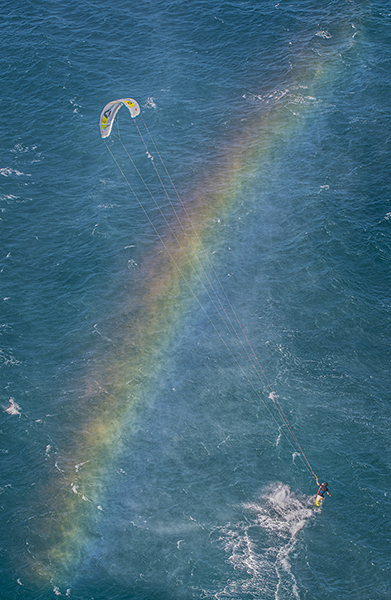
70-200mm (70mm), F/3.5, 1/1000th sec., ISO 100
Click image to view larger
On this particular day, Michael spotted this kiteboarder—basically a guy on a small surfer-like board who uses the power of the wind to gather speed. “I happened to look out at just the right moment and saw this rainbow, with the kiteboarder below it,” he says. “Normally when you take a picture of a kiteboarder, you only get the board in the picture, because the kite is so far away. Thanks to my aerial view and the 70-200 lens (one of my old standbys) I happened to have with me, however, I was able to get the entire scene, including that rainbow. It was magical.”
Michael not only takes the skimboarders’ photos—he gives them samples. “I make posters out of my photos and hand them out on the beach the next time I go,” he says. “Now when I show up, everyone wants to be skimboarding right in front of where I’m sitting in my beach chair. Plus, many of these guys are avid amateur photographers themselves, so they’re already interested in the photos I’m taking and the Tamron lenses I’m using. I’ve loaned some of them out, and a few of the guys have even bought the 28-200. I could probably open up a little store down on the beach and sell Tamron lenses out of it.”
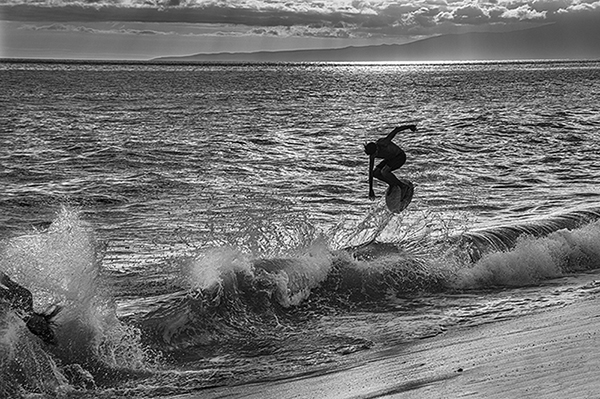
28-200mm (143mm), F/10, 1/1250th sec., ISO 640
Click image to view larger

28-200mm (129mm), F/5.6, 1/1600 sec., ISO 400
Click image to view larger
More Photo Tips | Watch Videos | Learn More About Tamron Lenses | Photo Gallery
